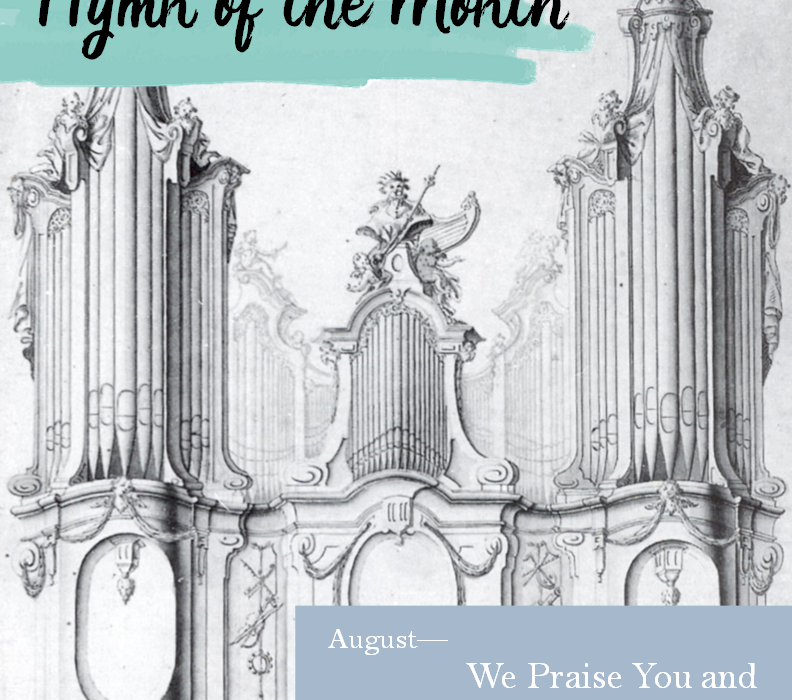Hymn of the Month
We Praise You and Acknowledge You, O God (LSB 941)
The Church’s hymnody, built up and beautified over millennia, is replete with profound poetry and moving melodies. But this month’s hymn is perhaps especially so, as it marries the text of the ancient Te Deum with the inspired music of Holst’s “Jupiter.” Yes, this month’s hymn is the much beloved “We Praise You and Acknowledge You, O God.”
The lyrics of our infamous “941” go back almost as far as the Early Church herself, as they are hymn-ified form of the text of the Te Deum (literally, “You, O God”; the Latin title of the canticle we sing in Matins on page 223). The Te Deum can be traced at least to the 500s A.D., probably having been developed over time in the liturgy, though it is often attributed by eccelsial legend to St. Ambrose and St. Augustine. Whether this apocryphal authorship is accurate or not, the content is definitely far older, for it is simply a combination of the creed with the Sanctus (“Holy, Holy, Holy…”). It is divided into three sections, each associated with a Person of the Trinity: if you turn to Matins, you can see the first page is heavily associated with the Father, the second with the Son, and the third with the work of the Holy Spirit in the Church. The Sanctus is embedded in that first section, as the eternal song of all the host of heaven, a song which we join in singing even here below. Especially by the Middle Ages, the Te Deum was such an integral part of the liturgy that Martin Luther called it the “Third Symbol” (symbol here meaning a representation of the Faith), the first two being the Apostles’ and Athanasian creeds.
Stephen Starke’s lyrics in our hymn are impressively close to the text of the canticle, keeping both the creed and Sanctus intact. Stanza three gives particular emphasis to the redemptive work of Christ, tracing His life from the virgin birth through His resurrection, making this a hymn appropriate for any time of the Church Year.
Interestingly, “We Praise You and Acknowledge You” was not Starke’s first attempt at setting the Te Deum. In the 1990’s, he wrote a version which he entitled “Alleluia! God Eternal,” and set it to the tune of “Thy Strong Word.” (Secretly, I wish we had that version somewhere…). However, he was later introduced to the English patriotic hymn, “I Vow to Thee, My Country” (a fantastic hymn, by the way), which is sung to the tune of Gustav Holst’s “Jupiter,” from The Planets. Musing that this, “being such a strong tune, could carry the weight of a strong text, like the Te Deum,” he rewrote his versification especially for this tune, and hence was born our beloved hymn.
It is worth noting that, if you have ever listened to the entire movement of Holst’s “Jupiter,” you might recall that the tune we know and love is only a part of the song. Holst’s orchestral suite channels the namesake of the respective planets, drawing forth the character of each of the pagan gods. Jupiter, the greatest of the gods, is also called the “Bringer of Jollity.” Much of the movement dedicated to him is driven by exhilarating strings and almost frenetic rhythms, giving the listener an irresistible sense of jollity, appropriately enough. However, although Jupiter brings that festal happiness, he is also king of the gods, and so his regal presence demands reverence. Accordingly, the musical merry-making comes to an abrupt hush almost halfway through the piece, as trumpets declare that the king has arrived. With that, the majestic tune we all know begins, and one can imagine the king of the gods gracing the royal hall, filling the hallowed throne room with his presence.
This music paints a portrait of the mythical gods, but we worship the One True God. Though what Holst depicts is based on fiction, the sentiment is real: there is a God, the King of all the host of heaven. He is the “joy of man’s desiring,” bringing jollity, as it were, far beyond the imagination of the pagan gods. And because He is the grave and revered King, we hail Him with all the laud and grandeur our hearts can offer.
The next time you sing this hymn will likely be in the Divine Service. Though you enter a temporal building, with mundane carpet beneath your feet and groaning arches overhead, there you need not imagine the throne room of God. For there, upon the Altar, heaven envelops earth into the eternal liturgy; there, in the Divine Service, you are in the divine throne room. The King of All has come to dwell among us, and heralding His presence, we burst forth in songs of praise, shouting, “We praise You and acknowledge You, O God to be the Lord…”



